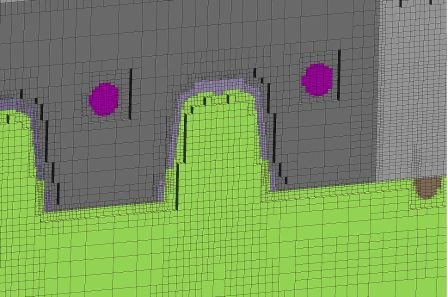News in Molding Simulation at K 2013 Show
Close Up: Simulation
At October's K 2013, suppliers of injection molding simulation software displayed solutions addressing a number of hot topics, as well as technology to speed up handling of larger models and multiple iterations.
Suppliers of injection molding simulation software are addressing a number of hot topics of current interest to injection molders—conformal cooling, variotherm molding, multi-shot molding, high-strength composites, LSR, and powder molding—as well as the need for greater solving speed to enable handling of larger models and multiple iterations within a practical time frame. Those trends were evident in the new developments in simulation displayed at October’s K 2013 show in Dusseldorf, Germany.
SOPHISTICATED COOLING TECHNOLOGY
Among the latest developments from Autodesk Moldflow, Waltham, Mass., is simulation of two promising tooling technologies: conformal cooling—using Autodesk’s computational fluid dynamics (CFD) capabilities—and variotherm (hot/cold) mold cycling. For simulating the latter, Moldflow software now allows the user to change the inlet temperature cycle, which cycle can be defined by the user or controlled through a “virtual thermocouple.” Conformal cooling can be combined with variotherm technology for optimal control of mold temperature.
Also new in Autodesk Moldflow is simulation of injection-compression or pure compression molding of thermoplastics or thermosets (SMC or BMC). Also, Autodesk Moldflow is said to be investing considerable time in developing simulation for injection overmolding of continuous-fiber composite sheets. The company continues to work on simulation of liquid silicone rubber (LSR) molding, which includes building a database of material properties.
Another development project within Moldflow group is predicting surface roughness of parts made by additive manufacturing processes. Software is being developed for CAD model cleanup, simulation of the the 3D printing process, and solid modeling of the part and its visual appearance.
MEETING THE NEED FOR SPEED
Faster optimization of new mold designs and process setups is promised by “Virtual Molding” technology introduced last fall by Sigma Engineering of Germany (U.S. office in Schaumburg, Ill.). This is made possible by the much greater speed of the latest release V5.0 of Sigmasoft simulation software. Such speed results from the ability to utilize multiple CPU cores and from redesign of the solvers so as to automatically coarsen the model mesh where fine detail is not required and refine the mesh where detail is needed, resulting in fewer mesh elements overall. The end result is the ability to simulate so much more detail of the mold than was practical before and provide multiple iterations within a reasonable time. Virtual Molding is a comprehensive 3D approach to the complete mold—including hot runners, inserts, and various mold component materials. Multiple iterations are useful for testing the effects of changing process variables on cycle time and part quality (warpage). Modeling multiple cycles also determines how long it takes a mold after startup to achieve thermal equilibrium and process stability.
For example, Sigma sources say it would have been very time-consuming in the past to model the performance of an entire hot-runner manifold over multiple cycles to take into account the long-term effects of shear heating and pressure drops. Other types of mold detail that can now be considered efficiently include small air gaps that act as heat insulators or complete hot-runner nozzles with electrical heating elements.
Sigma recently modeled a large auto instrument-panel mold that would have required an astounding 500 million mesh elements in the past, but the software automatically reduced that to 50 million elements without loss of accuracy. That’s still a very large model by historical standards, yet Sigmasoft V5.0 was able to model 40 consecutive cycles of that mold, taking just 2.5 min for each cycle. That makes it practical to test out the effect of different process settings or cooling-line layouts in Virtual Molding rather than on a real molding machine, Sigma sources explain.
The latest V.12 of Moldex3D from CoreTech System Co., Ltd. of Taiwan (U.S. office in Northville, Mich.) is up to 80% faster and can model compression molding of long- and short-fiber reinforcement orientation and its effect on thermomechanical properties through integration with Ansys Workbench for finite-element analysis (FEA). It can also predict the degree of fiber breakage in injection molding. Also new is 3D cooling CFD, which simulates water flow in 3D cooling channels to help optimize cooling design and cycle time and predict hot spots. New venting analysis can predict burn marks.
Modeling of metal or ceramic powder injection molding (PIM) and of two-component injection are other new capabilities. Others are modeling post-mold annealing and non-round runners and gates and automatic gate location in non-shell models.
Related Content
Are Your Sprue or Parts Sticking? Here Are Some Solutions
When a sprue or part sticks, the result of trying to unstick it is often more scratches or undercuts, making the problem worse and the fix more costly. Here’s how to set up a proper procedure for this sticky wicket.
Read MoreHow to Optimize Pack & Hold Times for Hot-Runner & Valve-Gated Molds
Applying a scientific method to what is typically a trial-and-error process. Part 2 of 2.
Read MoreHow to Select the Right Tool Steel for Mold Cavities
With cavity steel or alloy selection there are many variables that can dictate the best option.
Read MoreUnderstanding the ‘Science’ of Color
And as with all sciences, there are fundamentals that must be considered to do color right. Here’s a helpful start.
Read MoreRead Next
Processor Turns to AI to Help Keep Machines Humming
At captive processor McConkey, a new generation of artificial intelligence models, highlighted by ChatGPT, is helping it wade through the shortage of skilled labor and keep its production lines churning out good parts.
Read MoreUnderstanding Melting in Single-Screw Extruders
You can better visualize the melting process by “flipping” the observation point so that the barrel appears to be turning clockwise around a stationary screw.
Read More











.png;maxWidth=300;quality=90)














